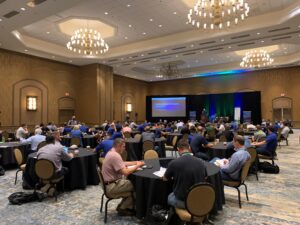Millennials in Preconstruction
On a busy Tuesday morning, we sat down with a new preconstruction hire at The Beck Group to talk about the intricacies of the industry, the future, and what it’s like being a millennial in the workforce. Blake Shrauner is a recent Texas A&M University graduate who was hired as a preconstruction engineer spring of 2019. Though he is new on the job, he’s well-adjusted in the world of preconstruction.
According to Blake, the world of preconstruction is about pioneering advancement in the construction industry. He says, “I think a lot of preconstruction is figuring out how things can be as efficient and accurate as possible so that things go smoothly in the field.” The importance of preconstruction lies in the behind-the-scenes action that maximizes the efficiency and accuracy of each project. Estimators connect an architectural idea with a constructor’s plans by bridging the gap. An estimator’s ingenuity is in the clever application of A/E/C knowledge to result in a cost-effective and viable plan that aligns with the original idea. With emerging technology, the preconstruction industry has the opportunity to use new software and systems to reach their goals in a shorter time with highly accurate figures and fewer mistakes that result in delays. The role of an estimator lends itself to creativity in a decisive sense.
Blake says that the most exciting and most challenging aspect of the job is collaborating with a wide variety of people in different roles. “Understanding how to get lots of people to work together is a challenge but it’s also fun to try and find ways to make that happen,” he says. Every day he gets to interact with people of diverse opinions, personalities, and positions. He enjoys the collective effort of projects at Beck, saying, “It’s really neat to be part of a company that does integrated projects.” The architects, engineers, and constructors have different schedules and ongoing tasks that make scheduling face-to-face meetings a challenging, but necessary, process. Conversations with people in different departments broaden his view of a project because, for example, the architects have a different viewpoint and process to an estimator. Blake’s associates are influenced by their departmental processes and their perception of problems in group tasks is unique. Each person benefits from the project because people in diverse roles are able to lend their expertise to a plan.
Recruiting for preconstruction can be difficult because many college students do not have an image of the daily activities and responsibilities of the role. Even then, the different aspects of the job are changing with the increased presence of technology. If more university students are exposed to the exciting, collaborative, and imaginative elements of the job, they’ll be drawn in and interested before firms recruit them. Blake says his idea of preconstruction before he was hired was that his job would involve a lot of “sitting and counting.” The actual role involves much more interaction than Blake expected. Though the objective of preconstruction revolves around the cost, viability, and efficacy of construction plans, the process can involve redesign. Preconstruction professionals use innovation and originality to problem solve and identify issues. The hidden creative and social aspects of preconstruction, along with the benefit of new technology, play a huge role in attracting new talent.
The daily activities of an estimator grow more exciting over time with technology that disrupts and reforms the routine. According to Blake, the biggest changes will be with software that improves communication: “I think it will be easier to make changes and create projects without necessarily having to be in the same room, like integrated software that allows multiple people to edit a project at the same time.” That new software is alluring to a young crop of college graduates who are intuitively interested in new technology. Software that allows for more conversation without face-to-face meetings allows estimators to use their time more efficiently since less time is spent waiting for a meeting. Because they need information from people in different departments, firms, and even time zones this will make communication and scheduling natural. Likewise, if multiple people can work on one project and share progress there is less potential for scheduling delays. Recruiters can focus on the recent software advances to challenge some college students’ narrow view of preconstruction. As Blake said, preconstruction is at the forefront of innovation in the industry, and recruiters would benefit by accentuating the role of technology in the position. Widespread collaboration is the biggest challenge and benefit of the role, and as a result, communication development has the biggest potential for change as well as the biggest attraction in recruitment.
For many people in the next generation of preconstruction talent, embracing and using technology is intuitive, and they are drawn to companies who are leading the way in advancing the use of preconstruction software. For the future of preconstruction, it’s clear that the way forward is to capitalize on the next generation’s innate drive for innovation.















